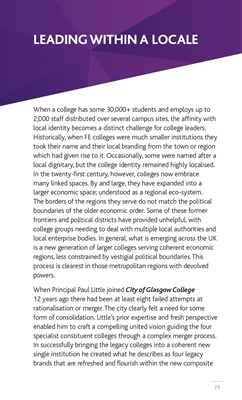
29
LEADING WITHIN A LOCALE
When a college has some 30,000+ students and employs up to
2,000 staff distributed over several campus sites, the affinity with
local identity becomes a distinct challenge for college leaders.
Historically, when FE colleges were much smaller institutions they
took their name and their local branding from the town or region
which had given rise to it. Occasionally, some were named after a
local dignitary, but the college identity remained highly localised.
In the twenty-first century, however, colleges now embrace
many linked spaces. By and large, they have expanded into a
larger economic space; understood as a regional eco-system.
The borders of the regions they serve do not match the political
boundaries of the older economic order. Some of these former
frontiers and political districts have provided unhelpful, with
college groups needing to deal with multiple local authorities and
local enterprise bodies. In general, what is emerging across the UK
is a new generation of larger colleges serving coherent economic
regions, less constrained by vestigial political boundaries. This
process is clearest in those metropolitan regions with devolved
powers.
When Principal Paul Little joined City of Glasgow College
12 years ago there had been at least eight failed attempts at
rationalisation or merger. The city clearly felt a need for some
form of consolidation. Little's prior expertise and fresh perspective
enabled him to craft a compelling united vision guiding the four
specialist constituent colleges through a complex merger process.
In successfully bringing the legacy colleges into a coherent new
single institution he created what he describes as four legacy
brands that are refreshed and flourish within the new composite